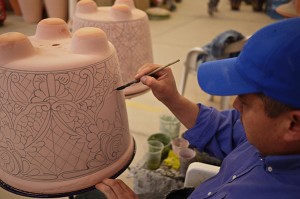 Ceramics in Mexico date back thousands of years before the Pre-Columbian period, when ceramic arts and pottery crafts developed with the first advanced civilizations and cultures of Mesoamerica. With one exception, pre-Hispanic wares were not glazed, but ratherburnished and painted with colored fine clay slips. The potter’s wheel was unknown as well; pieces were shaped by molding, coiling and other methods.
Ceramics in Mexico date back thousands of years before the Pre-Columbian period, when ceramic arts and pottery crafts developed with the first advanced civilizations and cultures of Mesoamerica. With one exception, pre-Hispanic wares were not glazed, but ratherburnished and painted with colored fine clay slips. The potter’s wheel was unknown as well; pieces were shaped by molding, coiling and other methods.
After the Spanish Invasion and Conquest, European techniques and designs were introduced, nearly wiping out the native traditions. Indigenous traditions survive in a few pottery items such as comals, and the addition of indigenous design elements into mostly European motifs. Today, ceramics are still produced from traditional items such as dishes, kitchen utensils to new items such as sculptures and folk art. Despite the fame of the prior, the bulk of ceramic items produced in the country are floor and wall tiles along with bathroom fixtures. Mexico has a number of well-known artisan ceramic traditions, most of which are in the center and south of the country. Examples are the Talavera of Puebla, the majolica of Guanajuato, the various wares of the Guadalajara area, and barro negro of Oaxaca. A more recent addition is the production of Mata Ortiz or Pakimé wares in Chihuahua. While the number of artisans has been dropping due to competition from mass-produced items, the production of folk art and fine ware still has an important role in the Mexican economy and the production of pottery in general is still important to Mexican culture.
Since the 16th century, Mexican craftsmen have been producing Talavera pottery. This art form has evolved from ancient cultures and influenced the production of pottery in Mexico resulting in the exquisite Talavera pottery that is available today. True, certified Talavera pottery is produced in the city of Puebla, in the state of Puebla, Mexico however, high-quality, modern Talavera pottery is also available from factories in other Mexican districts such as Dolores Hidalgo and Guanajuato.
Age-old techniques have been passed down from generation to generation by master craftsmen. These techniques produce unique pieces that are truly works of art. Vibrant colors and delicate details are trademarks of Talavera pottery that give it the characteristic color and brilliance known only to Talavera ware.
Talavera is a type of majolica earthenware that is fired at extremely high temperatures producing a very durable product. Artisans are not limited to the production of tiles and vases. You will find beautiful pieces to suit your taste in plates, jars, pots, religious figures, animals and more!
